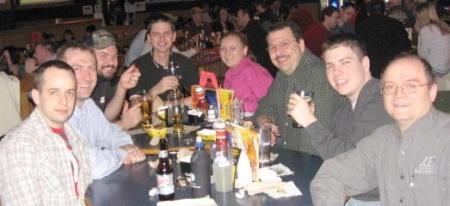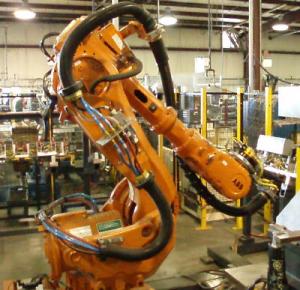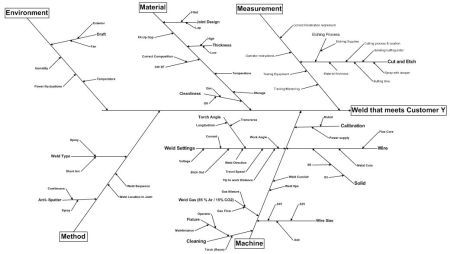On Shoulders of Giants – Part 2
Continued from Part 1 here.
Only fifteen years after my LeTourneau graduation did I realize that the availability of welding science expertise in industry is in fact, sadly rare. Even ridiculous. It hit me when Yoni Adoni (OSU/LeT-U) explained that the raw numbers for W.E. graduates and Welding Engineer job titles reveals that 70% of “Welding Engineers” don’t have the degree. As the overwhelming rule of thumb, they are “familiar” with one or two welding processes but have little or no welding science training.
This holds the weighty implications that degreed W.E. compensation centers around the 85th percentile, and that true, un-hyped “blue ocean” advantages exist for companies who infuse their company’s core with welding science competency and nurture it.
These realizations evoked yet another puzzling frustration: how could it be that 95% of company engineers, managers and executives, and 99% of HR managers or directors seem unable to comprehend and leverage such obviously valuable opportunity, fully exploiting welding science for competitive advantages? Surely I’m not the only one with two eyes in my head!
Like Morpheus’ splinter illustration to Neo (The Matrix), there was a splinter in my mind: amidst all of this there were two things that especially stumped me over the years. First, the wide gap between EWI’s applied welding process expertise, and my expertise. Second was a maddening, incomprehensible industry-wide ignorance that is blind to the existence of both welding sciences and welding engineers.
- How could I have TWICE unknowingly come into a facility behind an Edison Welding Institute (EWI) TEAM investigation report, and bested EWI engineers by predicting and delivering welding process improvements of 500%+ beyond what their evaluation said was possible? There is nothing shabby about EWI’s remarkable achievements – they are arguably the most renowned and most capable pool of consulting welding expertise on the globe.
So how does this make any sense? How is it that:
- A new (1993?) Carrier compressor plant told me that their single biggest problem – a joint made by one simultaneous 10-point Resistance Projection Weld – couldn’t be fixed until they re-designed and re-tooled a completely different approach, which would total nearly a half-million dollars. I objected that it posed no problem to weld, and was probably a superior design – despite the new-launch failure rate which often exceeded 50%. But those decisions made several days earlier were grounded in the fact that both the RW machine builder and an EWI team had concluded that it could not work and that the only solution was to revert to an industry-standard design. I looked it over for 15 minutes, went back and told him all he had to do was reduce the force, increase the amps and volts, and shorten the weld time, and it should be no problem. A week later they let me and a T.J. Snow staffer take 45 minutes (wink) to develop a new weld schedule and machine settings. 30 minutes later, they couldn’t separate more than two projections in over 50 hits from a 32-oz ballpeen hammer (literally) that completely flattened all the sheet metal. Yet, until that moment, whacking it twice without snapping it completely off was labeled as “good” because that was the best ever accomplished.
What?!!?
How do I make sense of erasing this simple half-million dollar “impossibility” in 30 minutes, with no tooling or machine hardware changes, based on a 15 minute evaluation? Were EWI’s main RW experts and the RPW machine-builder’s lead staff ALL on longggg vacations? Can’t any good welding engineer do this stuff? - A two-week EWI team investigation in the mid-90’s provided a filled three-inch ring-binder report which concluded that Copeland Corp’s (Emerson Electric) flagship scroll-compressor plant headquarters production facility was doing fantastic in their RPW/GMAW/Brazing/Friction-welding production as the industry leaders and that they might be able to accomplish 5 to 10% reductions in welding rework & scrap. Months later after a pre-interview one-hour plant tour, I was shown charts on their weld defect/scrap tracking, and pointedly asked how much improvement I thought was possible. Encouraged to sit and ponder it at length, I took four minutes to consider everything I’d seen on the floor, and told Gerry Ulrich that with teamwork we could cut those rates by 50% the first year and cut it in half again the second year for a 75% reduction.
When Gerry asked my certainty, I said I was confident in the first 50%, and felt the 2nd year was a bit conservative because I suspected we could do better. (I knew nothing about EWI’s study and report until months later.) A year later we were at 50%, and ending the 2nd year we had reduced FPY losses by 80% since my interview. (Although Copeland never understood what really happened or how to fully leverage it, varying portions of what I accomplished was franchised into many new plants across the US and the globe.)But any good welding engineer can do this, right? Ten years into my career, my confidence in that assumption was eroding, and it disturbed me. I was perplexed by EWI’s inability to provide more benefit to their customer than they did with four(?) W.E.’s in two weeks, but I slid it unexplained onto the back burner, where this puzzle intruded into my mind a thousand times.
- How is it possible that the 95%+ majority of manufacturers who daily sell their expertise at making complex welded assemblies think that they do something else, just because it superficially looks like an aerospace battery enclosure, an EGR cooler, an automotive seat frame, a truck axle, a nuclear valve, or a compressor?
Worse, companies think that staff or vendors without extensive welding science training can design and program a welding automation system that is infused with process expertise to deliver high-profit, high quality results with huge competitive advantages. That will NEVER, EVER happen – yet that myth appears to be the prevailing “conventional wisdom”
The final piece of my mental puzzle was in coming to grips with myself. “I want to make a difference” is an inadequately shallow description. In every job I’ve ever had, my goal has been to understand the company and chart a path to guide their unique cultural blend of talent through thousands of un-comprehended complex details, to reach achievements and performance levels that had never been thought possible. This, too, I imagined was something that “every good welding engineer” did. But they don’t.
All of this spiraled into many interwoven questions that tumbled in my mind for years like threads in a dryer, seeming to defy every attempt to untangle and weave them into a cohesive, accurate explanation:
- WHAT IS SO WRONG WITH EXECUTIVE MANAGEMENT TRAINING PROGRAMS THAT EVEN VERY SHARP EXECUTIVES DON’T SEE A GRADUATE WELDING ENGINEER AS A VITAL TECHNICAL ENGINEERING MANAGER ON THEIR DIRECT-REPORT TEAM?
- Why do very smart people see no problem when technically ignorant people get to override a degreed welding engineer with financially costly errors that demand long hours from their W.E. to even partially compensate for them?
- Endlessly following mythical welding “facts”, tribal “knowledge” and committee-decision technical nonsense… how is that a good strategic policy for explosive growth and low turnover of their most crucial technical expertise?
- How is it not inherently obvious that as the most complex industrial processes by far, blending more sciences and interactive process control variables than any other, welding science must become a Core Competency if they are to ever remotely approach their facility and corporate potential?
- How can a leading automotive Tier I supplier of welded metal assemblies believe that a major quality spill is due merely to an accidentally deleted pause after arc-start, before the robot starts moving? How can they not see the true root cause is in not having one single welding engineer among more than 10,000 employees in over 50 global facilities, and that such blindness makes costly welding quality problems a certainty?
It is questions like these that kept me puzzling, got me researching, and kept haunting me. Finally I’m at a point in my career where the many complexities have coalesced, and I’ve been able to analyze and rationalize these systemic industry roadblocks.
In a simple nutshell, here is the core root-cause of these blindnesses:
Industry and management are ignorant of the existence and power of welding sciences and welding engineering, simply because they’ve never been taught.
Some have been told, but very rarely have they been taught. A three-page e-mail to an engineering & management team is a sure-fail method to teach them a foreign language and culture that they have never been exposed to. I know. I’ve spent hundreds of hours trying to find ways to TELL, and it has only exhausted me while frustrating everyone. Simple facts can be told, but complex matters can only be taught.
Why don’t at least SOME companies recognize this “blue ocean” opportunity and infuse welding science as a core competency with a determined growth strategy, and include serious succession planning for senior welding engineering staff?
Don’t companies want to make money, gain marketshare, and catapult their future forward?
Yes. But in the stark manufacturing world beyond CATERPILLAR and John Deere, such commonplace business goals are rarely applied to the practical welding sciences that are strewn across the entire plant. In this one arena of welding, this one arena only, the myths, excuses, guesses, tribal knowledge, medicine-men and folklore still substitute for common-sense business. Despite massive profit losses in welding, over 98% of executives, managers and engineers show no interest in welding performance data tracking that could de-cloak both those losses and their potentials.
Can’t they see the vastly untapped potential of welding science expertise? No. Definitely not.
After decades, I’ve realized there are definitive reasons for the common welding blindness’s of both engineers and managers, as well as executives. They are embedded firmly in the chronological industrial timeline, which is hinted at by the late appearance of welding physics, equipment and process development. But the magnitude of this problem is revealed in a simple organizational survey question: how many of your staff have had at least one welding science, welding process, or welding equipment class? Contrast that with the classroom and lab training that welding engineering programs provide, and your first glimpse of the size of this chasm will come into view.
Despite being the most complex industrial processes, applied welding science studies were never mainstreamed into collegiate engineering, management, and manufacturing processes curriculum. In fact, only three universities ever created substantial ABET-accredited degrees in welding engineering. Understanding this history finally makes it possible, for the first time, to build effective strategies to unleash advancements and competitive advantages in this barely-explored territory.
I’m skilled at developing custom training programs – finding development bandwidth is the challenge. Yet if I can find some means to get this knowledge into manufacturing management, engineering managers and corporate executives, and chart paths around the obstacles, my knowledge could enable immense sea-change benefits. If I can pave that road, then a few other welding engineers and their companies will be able to follow.
On that coins’ flip-side, if I do not find my voice, and ways to speak up and speak effectively, it’s unlikely that my abilities will ever be used to the extents they could be leveraged to transform profits and launch companies manufacturing welded assemblies into global orbits of excellence that leave historical legacies of market dominance.
Joe Beckhams’ parting advice and comments indirectly convinced me that I need to write the book I’ve pondered for the last decade:
Toward World Class Welding.
I probably should write it. But I naturally wonder, would there be significant interest? Would it make a difference?
Perhaps it would. Maybe the simple fact that words printed in a book that are being read by a company I don’t work for, could induce the assumption that I have noteworthy expertise in manufacturing welding process science.
If you’ve read this far, thank you for enduring my rambling points of repetition and questionable literary skills. As a reward, I offer this career-long observation that I hope you’ll take to heart:
Any manufacturer with “good” welding processes who lacks a welding-degreed engineer among more than a hundred employees is very likely losing more than 10-times in profits what a full-time Smart Welding Engineer would cost – one who could deliver those lost profits to the bottom line.
 My talents shouldn’t go to waste when they could make a large impact for countless facilities. So if you’d like my assistance in any strategic or technical welding area, I do have weekends and some vacation time available. E-mail me and we’ll explore from there.
My talents shouldn’t go to waste when they could make a large impact for countless facilities. So if you’d like my assistance in any strategic or technical welding area, I do have weekends and some vacation time available. E-mail me and we’ll explore from there.
The Hall of Giants
My most notable mentors were/are these men:
- Bill Dorsey, an Electrical Engineer steeped in applied welding engineering who led development of one of the most successful and respected power supplies in the welding equipment industry, known in combination with the MIG-35 feeder for its exceptionally smooth arc, its dependable arc-starting, and its durable reliability. Bill was my main mentor. His brilliant mind was evident, and my frequent exposure to his systematic logical troubleshooting of welding processes and equipment, with running educational commentary, had value beyond description. In many ways, though I suspect it was unintended, I became his unpublished protégé. My absorbed abilities in welding system design evaluation and improvement have never been tapped to any extent beyond benchmarking and predicting production performance results.
- Ted Toth, a quiet in-the-shadows immigrant genius whose main legacy was the architecture and control algorithms for the legendary Digipulse 450 that especially ruled Electric Boat for over a decade and the Korean shipyards for two decades. Ted was genuinely excited to work with me ten years after I left L-TEC/ESAB N.A., to take the waveform I developed for automotive exhaust with 409/439MC and give me a fully synergic version across the whole WFS range. Then months later I called him with a proposal for how I would love to see tip-burnback-prevention built into the main arc control loop logic. With only a few minutes of my explanation of the control-logic approach, Ted was excited to plunge into it. Perhaps three weeks later he called to announce he was e-mailing me a new .bin to burn into the Digipulse E-ProM’s on our robotic welding systems. It was an instant success that ESAB immediately leveraged for their Al welding customers, where the impact was 10x greater.
- Joe Devito, a quiet, confident hands-on welder/instructor/trainer/lab developer and more. He had more influence on me than he suspected.
- To Rex Young, thank you for being the man I grew to appreciate so deeply: a kind, fun, thoughtful gold-mine of expertise, knowledge and advice in all matters of Resistance Welding.
- To Tim Iorio, thank you for the opportunity to have some of your strategic vision and heart rub off onto me, along with other invaluable things. You are often remembered.
- To Joe Beckham, the value of your parting words cannot be measured in a mortal lifetime. Thank you. I’ll probably have more to say. But for now, refer to the narrative above.
- To Daniel Mann, you’re a marvel and a brother. You walk a narrow, unmarked, untraveled path that’s well beyond sight of the 10 or 15 year learning curve in your position. You are an awe-inspiring pioneer. I wish we had more time beyond the next firefight, to learn from one another, collaborate and fully deliver the results we’re capable of. It would be epic.




 Posted by Brian Dobben
Posted by Brian Dobben 




